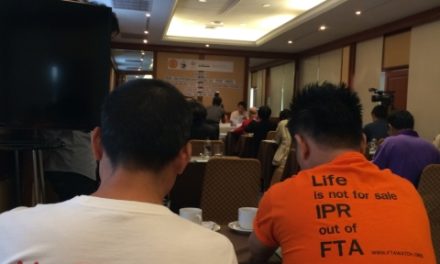by Walden Bello, in th Nation Newspaper, 11 August, 1998, Bangkok, Thailand
Thailand took pains to dispute any comparison to Mexico in the months preceding its economic meltdown. Now the Philippines insists that its economic woes are marginally different from its Asean neighbour, writes Walden Bello.
The peso has stabilised. The economy is back on course. The trade deficit is under control and the projected GDP growth rate of seven per cent will be achieved. People in the Philippines are today being bombarded with these reassuring statements from President Fidel Ramos and his economic team in the wake of the July 11 de facto devaluation of the peso, which followed on the heels of the depreciation of the baht over a week earlier.
Most important of all, Ramos and his advisers tell Filipinos, the Philippines is definitely not Thailand that the so-called ”fundamentals” of the two countries are different.
The likelihood, however, is that the peso will continue to be subjected to speculative attacks that will continue to drag its value down, with all the consequences of this development in the form of higher inflation, a lower growth rate and deterioration of the country’s external accounts. Indeed, in a few months’ time, it will be de rigueur for a candidate in the country’s coming presidential elections in 1998 be it Ramos’ anointed one or a challenger to run against the Ramos economic record rather than on a ”continuist” platform.
Why? Because both the short-term indicators, on which foreign investors and speculators base their moves, as well as the ”fundamentals” which determine whether the economy will remain on a steady growth path, point the wrong way.
The two most sensitive indicators that investors and speculators look at are the trade deficit and the current account deficit, which, among other things, indicate if a country has the capacity to pay for its imports and service its foreign debt. The trade deficit in 1996 stood at US$12.8 billion, or doubling in just three years!
And owing to the higher prices of key imports, such as electronic components, it is unlikely that the net effect of the recent depreciation will be a reduction from the pre-peso-flotation projection of US$14.6 billion in 1997.
But not to worry, say Philippine government analysts. The current account balance, which brings to bear on the positive side of the ledger the remittances from the Philippines’ vast army of overseas workers, is manageable; and the current account is, more than the trade deficit, what foreign investors, analysts and speculators look at in assessing the strength of the peso.
But even if one were to grant this argument, things look shaky. In 1996, according to estimates based on official figures, the current account deficit of US$3.5 billion stood at four per cent of the GNP. Worrisome but not alarming, say some.
However, when one tightens up the methodology for calculating the figure to account for unexplained errors and omissions in the balance of payments, as one prescient HG Asia study did last year, one comes up with the real current account deficit of around seven per cent of GNP a figure uncomfortably close to the eight per cent deficit experienced by Mexico and Thailand before their economic meltdowns began. With a deficit of that size, the pressure increases on economic managers to close the deficit by devaluing the currency relative to the dollar, thus making the country’s exports more competitive in dollar terms.
It was the uneasiness in foreign investor circles over the strong possibility of a devaluation that fostered the climate of uncertainty that invited the attacks on the peso from speculators, fund managers and investors. The crisis of the baht in neighbouring Thailand was simply the match that lit a volatile situation.
Lack of confidence
The perceived weakness of the Philippine currency, however, springs from more than just the current account deficit.
The weak peso is a sign of the growing lack of confidence among foreign investors in the country’s economic ”fundamentals”, to use a word much in vogue in financial circles. It is a symptom of a larger problem, and that is the current foreign capital-driven model of growth followed by the Ramos administration.
This is, of course, the Thai model of development, and while officials in Manila deny the comparison at every opportunity, the Philippines has followed closely on the footsteps of its Southeast Asian neighbour. Indeed, to use a particularly appropriate metaphor, the two are Siamese twins.
The Thai path was to drive high-speed growth through the massive infusion of foreign capital. The Thai special target was the massive pool of institutional funds circling the globe in search of profitable investment outlets, which has increased exponentially in the last decade.
Their formula was simple:
-Liberalise rules governing the entry of foreign capital, including allowing the lending of dollars onshore.
-Set local interest rates at a high level in order to attract foreign money.
-Ensure foreign investors against currency risks by pegging the baht to the dollar at a stable rate of exchange of around Bt25 to the dollar.
The formula was disturbingly similar to that followed by Mexico prior to the December 1994 crash. And, as in Mexico, the scheme was immensely successful in attracting foreign capital. Thailand became the favourite Asian destination of foreign investment, with its offshore lending institution, the Bangkok International Banking Facility attracting over US$50 billion in scarcely three years since it was launched in the early 1990s.
Following the Thais, the Philippine government eliminated foreign exchange restrictions and liberalised foreign capital entry by opening up the banking system to the participation of 12 foreign banks. Like the Thais, the Ramos administration pegged the peso to the dollar at a stable rate of exchange of around P26.50 to the dollar to eliminate the currency risk for foreign investors in the stock market and local recipients of dollar loans, so that for the whole of 1996, for instance, there was only a two per cent fluctuation in the peso-dollar rate.
Like the Bank of Thailand, the policy of the Philippine Central Bank (BSP) was to keep local interest rates high some 12 to 15 per cent in order to suck in foreign capital. This could then be re-lent in dollars to local businesses at much less than the local interest rate that governed peso loans.
And like Thailand, the Philippines enjoyed a rapid infusion of foreign investment, with some US$9.4 billion coming in 1996 alone. Some 75 to 80 per cent of that investment, according to some estimates, was not foreign direct investment which is considered more secure because of a longer-term commitment but portfolio investment seeking quick and high returns in the stock or bond markets.
Hot capital
Not surprisingly, a great part of this hot capital went into speculation in the stock market or into real estate and financial services, like auto loans and credit cards, instead of productive areas like agriculture and manufacturing.
Real estate loans in Thailand were estimated by the Bank of Thailand at 10 per cent of the total exposure of banks and 20 per cent that of finance companies, but most experts discounted these figures as gross underestimates. According to some calculations, property-related loans accounted for 50 per cent of all investment, and property development in all its aspects contributed some 30 to 50 per cent of annual growth of the gross domestic product.
In the early 1990s, the building cranes dotting the Bangkok landscape were a sign of the boom. By 1996, they were a sign of doom, as developers were stuck with unsold housing units totalling about US$20 billion in Bangkok. By 1997, half of the loans made to developers were non-performing, some of the country’s top financial companies were bankrupt and the credit rating of some of the country’s biggest banks were downgraded by Standard and Poor.
These developments triggered a deflation of foreign investor confidence; and the move of fund managers to convert their baht into dollars and get out of Thailand formed the context for the speculative attacks on the baht over the last few months.
The same search for quick and easy profits drove foreign capital to real estate, financial services, and financial institutions in the Philippines, with the exposure of commercial banks in these sectors coming to 21 per cent of total loans by 1996. The BSP claims that real estate loans account for only 9.2 per cent of outstanding loans, a figure doubted by many experts, who place the figure at more around 15 to 25 per cent.
Indeed, the central bank’s recent move to restrict real estate loans to the dangerously high figure of 20 per cent of banks’ loan portfolios instead of a safer 10 per cent limit is an admission that many banks are nearing or have breached the 20 per cent mark.
In any case, the building boom that began in 1994 paralleled the one in Bangkok that took place several years earlier, with the same results: over-extended, highly-indebted developers such as Megaworld, which nearly went under last April, and an oversupply of property units. The issue is no longer whether there will be a glut, it is how big it will be. All Asia, one local investment house predicts that owing to over-building by the year 2000, supply of high-rise residential units will exceed demand by 211 per cent, while supply of commercial developments will outpace demand by 142 per cent. Some local developers say that they are aware of the coming glut, so they are diversifying away from residential and commercial construction by building golf courses and tourist resorts!
Gambling on real estate
As the property sector faces oversupply, the truly productive sectors of the economy have stagnated in both countries. Drawn by the lure of easy money, many Thai manufacturers have gambled on real estate instead of investing in skill-upgrading and new machinery, leading to a decline in the competitiveness of the country’s exports. Export growth was zero in 1996.
In the case of the Philippines, manufacturing is in a tailspin, as is agriculture, as the radical liberalisation of trade and investment regulations that have paralleled financial liberalisation are making production less and less profitable for domestic producers. Duty free shops are flooding the country with cheap imported manufactured goods, and cheap, subsidised rice and corn imports are coming in volumes that far outstrip the minimum access volumes that the government committed itself to under Gatt-WTO.
Thailand is now experiencing an economic meltdown, with the country moving into its first recession in more than 10 years. Some true believers in the Philippine economic miracle still believe that the Manila-Bangkok comparison is false because the Philippines is in an early growth phase while Thailand, having had a decade of rapid growth, is naturally tapering off.
But the foreign fund managers that drive the economy couldn’t care less if a country is in an early or late phase of the growth process. If they lose confidence, as they have in Thailand and are in the process of doing so in the Filipino version of the Thai model of development, they will bolt.
Philippine economic managers should have learned from the bursting of the bubble economy in Mexico in 1994 that relying on massive capital inflows to drive growth is a recipe for disaster. But even as their model unravels next door, Philippine technocrats are drawing the wrong conclusions, trying to highlight marginal differences between Thailand and the Philippines in an effort to assure foreign capital that the latter’s ”fundamentals” are okay.
It won’t work.
Walden Bello is the co-director of Focus on the Global South, a programme of policy research at Chulalongkorn University, and a professor of sociology and public administration at the University of the Philippines. He is the author of several books on Asian development.









